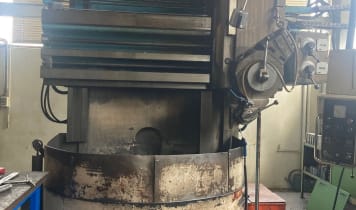The workpiece or component is clamped into the lathe ensuring that the workpiece does not slip out during the turning process. Due to the restrictions of big, short but wide workpieces, clamping from above is not necessary. The main difference between vertical and horizontal lathes is the influence of gravity and the lack of a second clamp (this is called the tailstock on horizontal lathes). The workpiece is moved by an electric motor and processed by a variety of tools. For hard metal products, a cutting process is used for the contour and surface area. Holes are created using drills and treads are created using thread taps. The workpiece is placed on a slide, where it then moves by the turning work tool, which is directed by installed programme.
DIEDESHEIM Vertical lathe in use
The turning process is not done manually, but follows the instructions of an inputted programme. The programmes are very easy to learn. Various companies provide free practice programmes on their websites for workers to learn how to programme those CNC vertical lathes. The CNC programmes can be tested using a simulation. However, only workers with a lot of experience and the right qualifications levels should be operating the lathe machine. Vertical lathes mainly differ in size. Small vertical lathes are used primarily for mass production and are joined over a defined feeder.
Loading is not conducted manually, but belongs to the automatic process. These machines are particularly well enclosed, to prevent injury from flying debris. Therefore, vertical lathes differ in the terms of the staff needed for operation. A piece of material is inserted into the machine and automatically formed into the desired shape. The staff only needs to be there to load and unload the product. Therefore, semi-skilled workers without prior experience can operate a vertical lathe.
This work is often also performed by industrial robots. These machines are particularly efficient due to the absent second grip, which causes the advantage of quick load and unloading. This is notable during mass production, where the machine produces a higher number of pieces per hour. To reach an even higher level of output most companies are using CNC vertical lahtes as they are able to produce the same amount of units in a much shorter time. A typical example of products resulting from this type of production are sockets and binding pieces for water or gas pipes.






